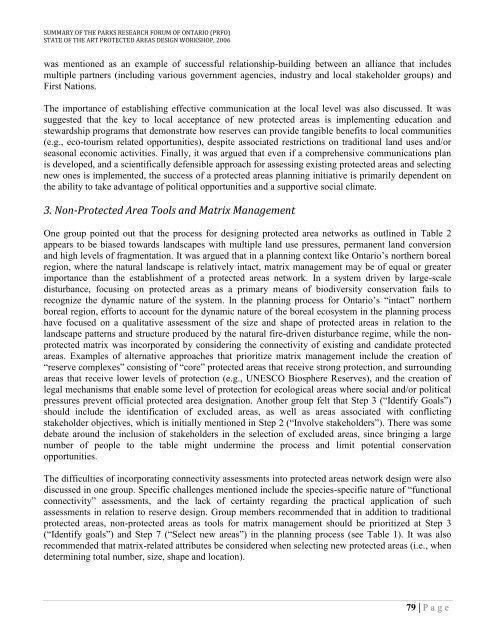Top-Down vs. Bottom Up: Working Towards Consensus ... - CASIOPA
Top-Down vs. Bottom Up: Working Towards Consensus ... - CASIOPA
Top-Down vs. Bottom Up: Working Towards Consensus ... - CASIOPA
- No tags were found...
Create successful ePaper yourself
Turn your PDF publications into a flip-book with our unique Google optimized e-Paper software.
SUMMARY OF THE PARKS RESEARCH FORUM OF ONTARIO (PRFO)STATE OF THE ART PROTECTED AREAS DESIGN WORKSHOP, 2006was mentioned as an example of successful relationship-building between an alliance that includesmultiple partners (including various government agencies, industry and local stakeholder groups) andFirst Nations.The importance of establishing effective communication at the local level was also discussed. It wassuggested that the key to local acceptance of new protected areas is implementing education andstewardship programs that demonstrate how reserves can provide tangible benefits to local communities(e.g., eco-tourism related opportunities), despite associated restrictions on traditional land uses and/orseasonal economic activities. Finally, it was argued that even if a comprehensive communications planis developed, and a scientifically defensible approach for assessing existing protected areas and selectingnew ones is implemented, the success of a protected areas planning initiative is primarily dependent onthe ability to take advantage of political opportunities and a supportive social climate.3. Non-Protected Area Tools and Matrix ManagementOne group pointed out that the process for designing protected area networks as outlined in Table 2appears to be biased towards landscapes with multiple land use pressures, permanent land conversionand high levels of fragmentation. It was argued that in a planning context like Ontario‟s northern borealregion, where the natural landscape is relatively intact, matrix management may be of equal or greaterimportance than the establishment of a protected areas network. In a system driven by large-scaledisturbance, focusing on protected areas as a primary means of biodiversity conservation fails torecognize the dynamic nature of the system. In the planning process for Ontario‟s “intact” northernboreal region, efforts to account for the dynamic nature of the boreal ecosystem in the planning processhave focused on a qualitative assessment of the size and shape of protected areas in relation to thelandscape patterns and structure produced by the natural fire-driven disturbance regime, while the nonprotectedmatrix was incorporated by considering the connectivity of existing and candidate protectedareas. Examples of alternative approaches that prioritize matrix management include the creation of“reserve complexes” consisting of “core” protected areas that receive strong protection, and surroundingareas that receive lower levels of protection (e.g., UNESCO Biosphere Reserves), and the creation oflegal mechanisms that enable some level of protection for ecological areas where social and/or politicalpressures prevent official protected area designation. Another group felt that Step 3 (“Identify Goals”)should include the identification of excluded areas, as well as areas associated with conflictingstakeholder objectives, which is initially mentioned in Step 2 (“Involve stakeholders”). There was somedebate around the inclusion of stakeholders in the selection of excluded areas, since bringing a largenumber of people to the table might undermine the process and limit potential conservationopportunities.The difficulties of incorporating connectivity assessments into protected areas network design were alsodiscussed in one group. Specific challenges mentioned include the species-specific nature of “functionalconnectivity” assessments, and the lack of certainty regarding the practical application of suchassessments in relation to reserve design. Group members recommended that in addition to traditionalprotected areas, non-protected areas as tools for matrix management should be prioritized at Step 3(“Identify goals”) and Step 7 (“Select new areas”) in the planning process (see Table 1). It was alsorecommended that matrix-related attributes be considered when selecting new protected areas (i.e., whendetermining total number, size, shape and location).79 | P a g e


